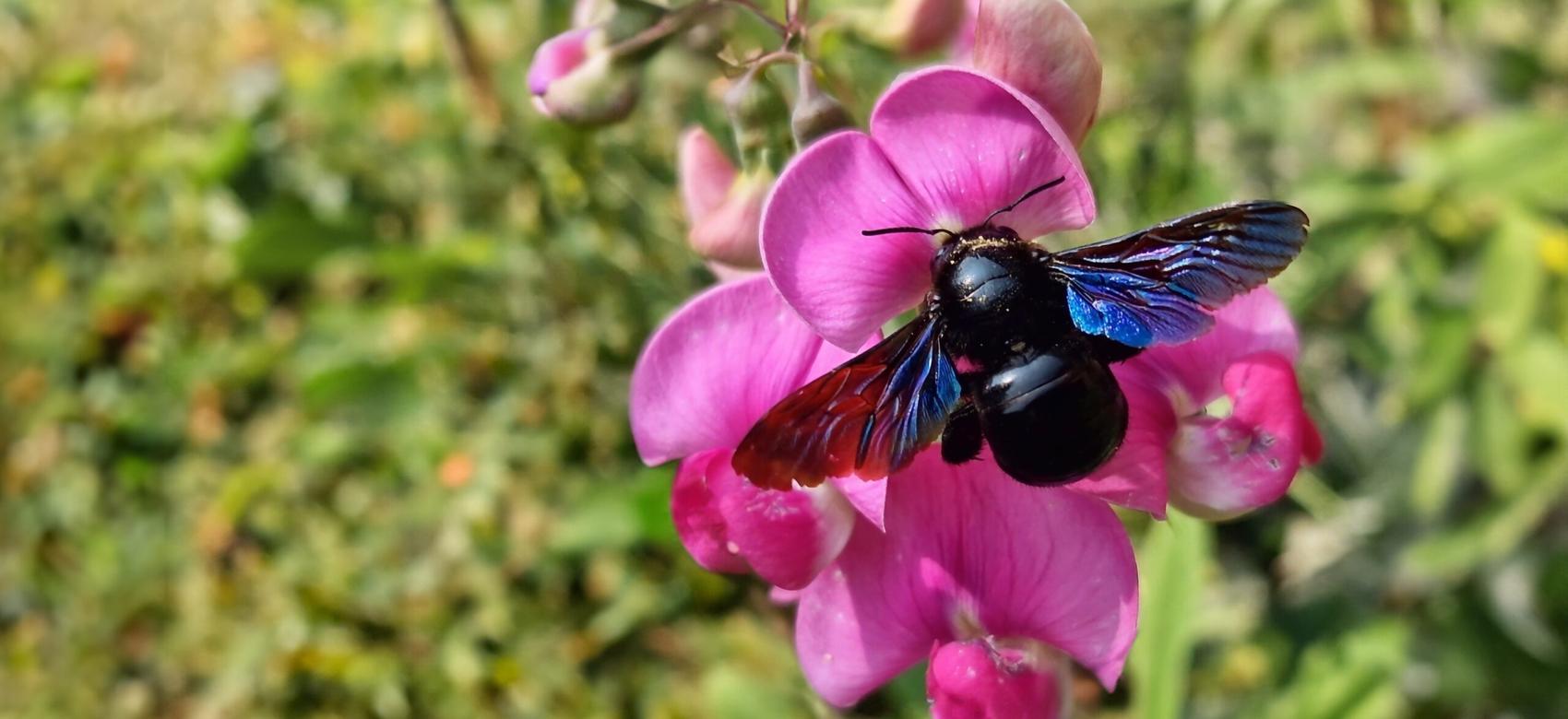Where the wild bees are—and aren’t—impacts food supply
By Lou Corpuz-Bosshart and Jillian van der Geest

Honey bees—plump, fuzzy and famed for their honey-making—capture the popular imagination. Yet, wild bees are equally vital for pollination and, by some measures, outshine honey bees as pollinators. This is why UBC researcher Matthew Mitchell and his colleagues are deeply concerned about their declining populations.
Dr. Mitchell, a landscape ecologist in the faculties of forestry and land and food systems, sheds light on the link between diminishing numbers of wild pollinators and reduced farm productivity in a recent study published in Environmental Research Letters. In this Q&A, he delves into the research findings and proposes ways the public can contribute to protecting wild bees.
Where can we find wild pollinators, and why are they essential?
Native wild bees—which include mason bees, carpenter bees, sweat bees and bumble bees—and other wild pollinators like moths, wasps, beetles and flies, are found everywhere: in parks and fields, near farms and forests. There are more than 800 species of just native bees in Canada, not counting other pollinators.
Wild pollinators play a vital role in pollinating various crops, including fruits, vegetables, nuts and oilseeds. Blueberries, cranberries, buckwheat, canola and orchard crops rely heavily on wild pollinators. Wild pollinators also help preserve biodiversity by facilitating the reproduction of numerous plant species.
Native pollinator populations are declining from habitat destruction and fragmentation, widespread pesticide use, and the spread of parasites and pathogens like mites and viruses.
What would happen if all wild pollinators were to disappear?
We’d likely witness a loss of native plant species reliant on wild pollinators, and significant crop yield reductions where wild pollinators supplement or are the sole pollinators of crops. Farmers would face higher costs to cultivate pollinator-dependent crops, as reliance solely on European honey bees wouldn’t always be feasible given current honey bee capacity. In some cases, farmers might shift production away from pollinator-dependent crops, leading to increased costs to consumers or scarcity of fruits and vegetables in supermarkets.
Your study focused on the impact of wild pollinator numbers on food-production potential. What did you find?
In Canada, wild pollinators aid in pollinating crops that generate an annual farm income of nearly $2.8 billion and produce calories and nutrients that could feed the equivalent of around 24 million people (although not all these crops are directly consumed by people, as some go to livestock).
Collaborating with colleagues at the Nature Conservancy Canada, we analyzed publicly available data on crops, farm income and nearby pollinator habitats such as forests, wetlands and grasslands to estimate the potential food production and farm income that could be gained if wild pollination was increased.
In Saskatchewan and Alberta, the two provinces most affected by lack of pollinator habitat near croplands, increasing wild pollinator habitat and populations could potentially increase food production by the equivalent of 11.5 million and 4.3 million people fed, respectively, and increase farm income by approximately $1.6 billion for Saskatchewan and $597 million for Alberta.
What can be done to reverse the decline?
Solutions include targeted conservation efforts, such as restoring pollinator habitat in areas where crops depend most on wild pollinators. It’s also crucial to promote sustainable farming practices that restore and maintain wild pollinator habitats near croplands.
On an individual or community level, urban gardens, especially if they include pollinator-friendly plants, can greatly benefit wild bees. Advocating for sustainable farming and habitat conservation can influence policymakers.
If addressed, targeted increases in wild pollinator habitat in Canada could help provide additional nutrition for an equivalent of 30 million people annually and increase farmer income by up to $3 billion every year. We would ensure the long-term health of native pollinators and enhance the sustainability and stability of Canadian agriculture and food supply. Without these types of actions, farmers will instead have to use other, potentially more costly, ways to increase productivity or will have to rely on honey bees.
Lou Corpuz-Bosshart is a writer with UBC Media Relations and Jillian van der Geest is a writer with UBC Faculty of Forestry. This article was published on April 12, 2024. Feel free to republish the text of this article, but please follow our guidelines for attribution and seek any necessary permissions before doing so. Please note that images are not included in this blanket licence.


